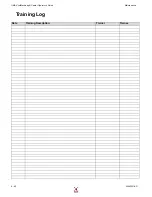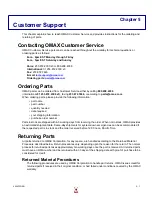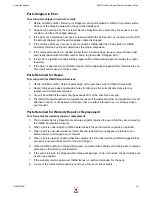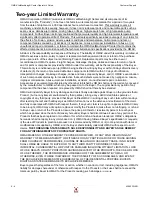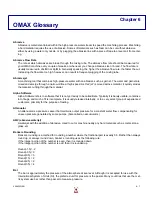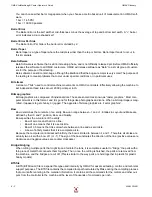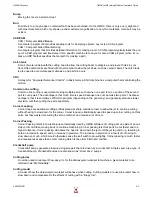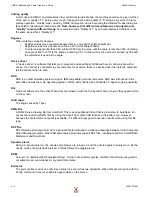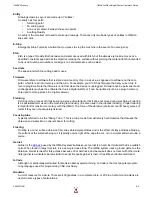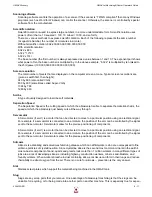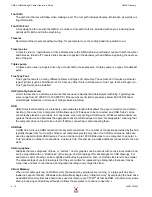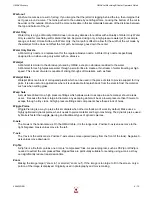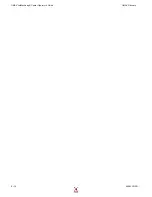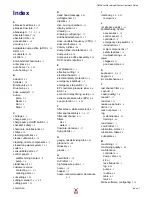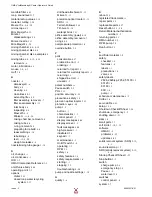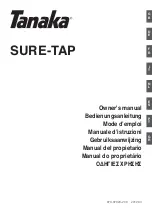
OMAX JetMachining® Center Operator’s Guide
OMAX Glossary
6 - 10
400433D-EN
PWJ (pure water jet)
A pressurized jet of water exiting a small orifice at extreme velocity. Used to cut soft materials such as foam, rub-
ber, cloth, paper, etc. See “Waterjet.”
Quality
Same as “Cutting Quality”.
Quality Numbers
Qualities that pierce the material and move at various speeds. Qualities 1 through 5 use abrasive and water to
pierce the material. A Quality of 1 will always pierce all the way through the material. Because the abrasive jet
head is moving quickly, however, the surface finish obtained with a Quality of 1 is rougher than that obtained with
a Quality of 5 (which is a smooth finish).
Ra
Ra (Average Roughness) is a measurement of surface roughness. Ra is calculated by taking the average of the
deviations from the center line of the surface. Ra is also known as Arithmetic Average (AA), Center Line Average
(CLA), Arithmetical Mean Deviation of the Profile. Ra is one of the more effective measures of surface roughness
and has been commonly adopted in engineering practice, as it is as good descriptor of variations in height of the
surface. Ra is frequently used in the automotive industry to specify a surface finish for metal.
Radians
The angle at the center of a circle that intercepts an arc equal in length to the radius. From these definitions, it fol-
lows that 1 revolution = 4 right angles = 360º = 2p radians.
RAM
RAM (Random Access Memory) is the main type of “memory” that a computer uses. It consists of high-speed
chips that provide storage for programs that the computer is running. When the computer is turned off, all the
contents of RAM disappears, so it is used primarily as “working” memory by the computer.
Raster graphics
Raster graphics are composed of individual dots. These are sometimes known as “bitmap graphics.” Most com-
puter artwork is in this format, and it is good for things like photographs and icons. When a raster image is mag-
nified, it appears to get chunky, or jagged.
Reticle
A grid or pattern that appears in an eyepiece to aid in positioning. The Precision Optical Locator uses a reticle to
precisely position the machining head.
Reverse Post Processor
A reverse post processor is a feature in some CAD / CAM (or other) software that translates a tool path back into
editable geometry. In other words, it is the opposite of creating the tool path (which is often created with a post
processor).
For example, when loading an ORD file into Layout, you are “reverse posting” it. Or if you have a “G-Code” file,
and you want to edit its geometry in your CAD program, you would use a reverse post processor to translate it
back into the CAD.
Reverse Taper
An upside-down V-shaped kerf (or a kerf with a negative taper error). This taper is caused because the abrasive-
jet stream tends to spread out as it travels. Typically, reverse taper can be reduced or eliminated by simply cut-
ting a little faster (assigning a lower Quality number).
Scanner
A scanner is a device for making a picture of a piece of paper and transferring it to a computer. Most scanners
work similar to a photocopying machine—a bar with a bright light and sensitive photoreceptors is moved across
the imaging area. The resulting image is sent to a computer, where it is stored as a bitmap image.
Содержание JetMachining Center 2626
Страница 8: ...OMAX JetMachining Center Operator s Guide viii 400433D EN ...
Страница 12: ...OMAX JetMachining Center Operator s Guide xii 400433D EN ...
Страница 22: ...OMAX JetMachining Center Operator s Guide Safety First 1 10 400433D EN ...
Страница 140: ...OMAX JetMachining Center Operator s Guide OMAX Glossary 6 16 400433D EN ...
Страница 144: ...OMAX JetMachining Center Operator s Guide Index 4 400433D EN ...

